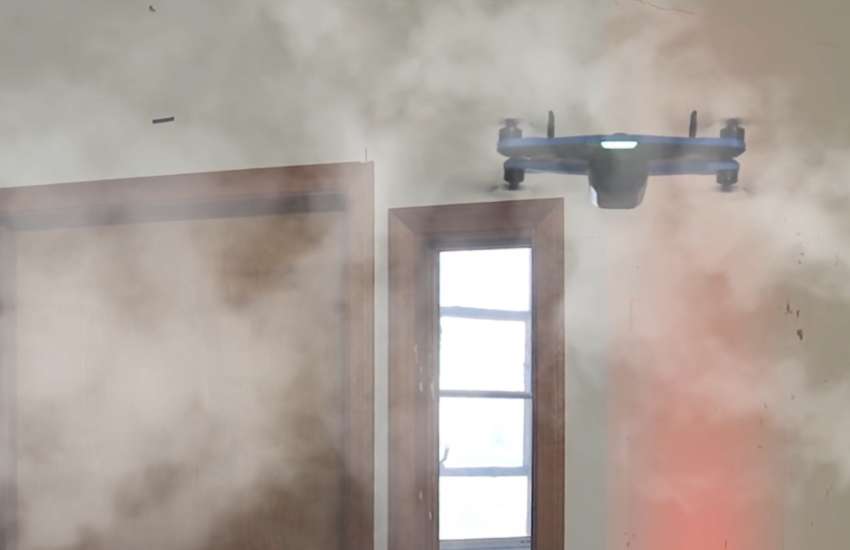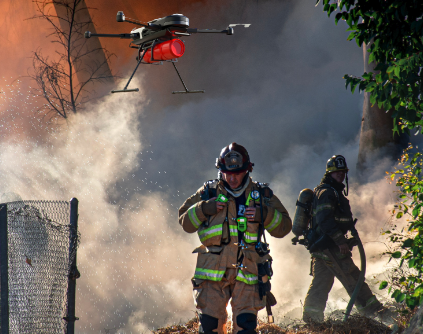UAS Capabilities Aid Public Safety
Since the horrific attacks on the United States on 9/11, the National Institute of Standards and Technology’s Public Safety Communications Research Division (PSCR) has led research to improve public safety communications and interoperability amongst diverse government organizations that aid the public during hurricanes, wildfires, tornados, crimes, catastrophes and other emergencies.
Public safety officials rely on a combination of legacy systems, modern-day radios, mobile technologies and emerging technologies to exchange vital voice communications and data in a crisis. And in the last eight years, this combination has been augmented by the onset of unmanned aerial vehicles, also known to the community as uncrewed aircraft systems (UAS), said Terese Manley, UAS portfolio lead and prize manager, PSCR.
“The way that we have developed our program is we continue to look at the needs and the mission of public safety, in protecting assets, properties and saving lives,” Manley explained. “But how we’ve developed our research portfolio has changed due to the evolution of the UAS industry and the applications that first responders—firefighters, law enforcement, emergency medical services—are using the drones for, whether it be for wildland fires, or urban fires, disaster areas or law enforcement SWAT teams.”
At first, the PSCR lab’s research and development of UAS examined the hardware and how certain design trade-offs would impact first responder operations. They considered how to have a drone fly in the air for as long as possible to a small cellular communications device to support the first responders’ ground communications for 60, 90 or 120 minutes. “We have evolved from those hardware aspects,” she said.
The evolution of drones and propeller technology, the extension in battery life, sensor advancements and network connectivity has enabled first responders to harness more data than ever, but this requires effective solutions.
“These days, we are also looking at software and the collection of data and how that is being managed by public safety agencies,” the UAS portfolio lead shared. “There is such a flood of data from all the different sensors and an increased number of sensors, whether it is sensors for heat or humidity, in the case of wildland fire. We are also looking at what happens ‘on board’ the drone and what is off-loaded and transmitted and managed ‘off board.’”
For SWAT teams entering a building using infrared camera sensors for detection, for example, data analysis solutions, including artificial intelligence and machine learning, are needed to help discern what information the UAS is providing.
PSCR’s early focus on advancing communication systems and solving interoperability issues stemming from 9/11 has even evolved as the scope of communications has changed. The PSCR helped develop location-based communication services, transitioned legacy land mobile radio to Long Term Evolution (LTE) devices and developed mission-critical voice capabilities for LTE, user interface and user experience technologies.
Advanced user interfaces, such as heads-up displays, voice commands, audio cues and haptic feedback all constitute ‘communications’ now. And drone technologies need to be able to connect with and leverage this level of advanced communication.
“Originally, we thought of communications as voice, but really voice has evolved into video and broadband communications and from that, what our first responders really need is real-time situational awareness,” Manley stated.
In addition to the internal research and development to support the UAS portfolio, the lab also drives innovation through external organizations—academia and industry—as part of its prize challenges. Manley and the portfolio team work with first responders to determine the next technology gap area to focus a competition on.
To date, they have run a total of seven prize challenges—with first responders and UAS experts serving as judges.
Some of the challenge areas included examining hybrid power models (gasoline engines and batteries) and recharging the battery with the fuel source; multirotor drones; different types of camera technology, algorithms and onboard computing to support image detection; and flying drones indoors without the benefit of GPS.

The PSCR’s eighth UAS prize challenge, launched in spring 2024, is a multistage effort with $730,000 in total prizes. It focuses on wireless data gathering for situational awareness “in radio-complex outdoor environments.” The lab is seeking enhanced UAS components related to innovative artificial intelligence, radio communications and Internet of Things.
The challenge asks companies or academia to present a single battery-powered, sub-55-pound UAS equipped with hardware, software and a ground control station. The systems should allow for geographic bounds and controls that can terminate the mission in the event of unexpected dangerous behavior and perform a radio survey of the environment, locating and inspecting ground sensors that it finds in a complex environment, the PSCR challenge guidelines specified.
“The systems should also be able to periodically communicate with and inspect the ground sensors for a predefined mission duration, which is expected to be well over one battery life for a multirotor helicopter,” the PSCR stated.
Potential contestants for any challenge need to understand that affordability and reducing aircraft and component costs are always a driver in each prize competition, Manley noted.
First responders may be able to easily harness military drones and run all the associated capabilities, for instance, but the price point could be $100,000 or even $500,000, which does not work with the budgets of city, county or state officials, she shared.
The movie industry can offer the most amazing camera technologies. But again, first responders will need systems in very small form factors for the drones to be light enough to fly for the longest time possible in emergencies.
“First responders, they still need all those capabilities, but they need that same technology in a more affordable, easy-to-use, smaller device that they can quickly bring to a scene and deploy in a few minutes,” she stated. “And innovation is actually a way to push those costs down.”
For the winners of the prize challenges, the PSCR also assists with the commercialization of solutions products, as supporting U.S.-manufactured drones helps to provide economic development, Manley said.





Comments